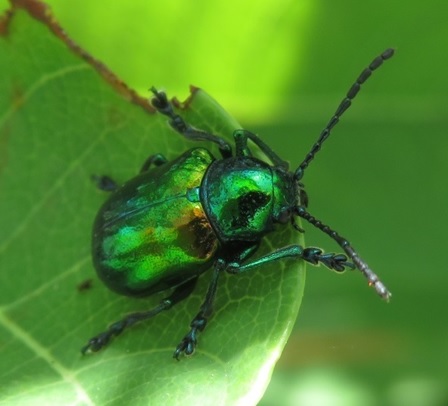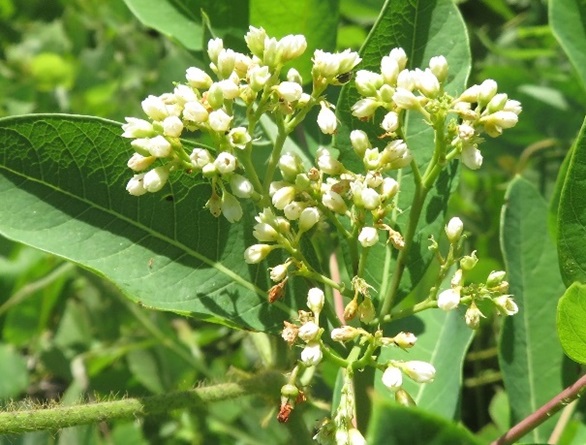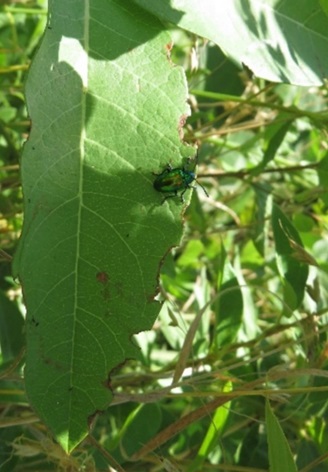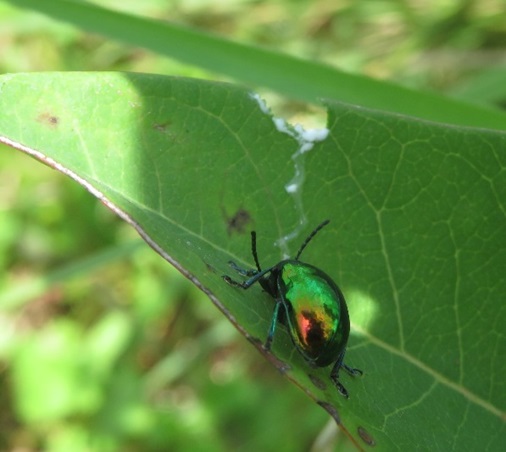Dogbane Beetle: Feeding on Toxic Plants Provides Benefits to Survive
ENTFACT-709: Dogbane Beetle - Feeding on Toxic Plants Provides Benefits to Survive | Download PDF
by Armando Falcon-Brindis, Entomology Research Associate and Raul T. Villanueva, Entomology Extension Specialist
University of Kentucky College of Agriculture, Food and The Environment
Description
The dogbane beetle (Chrysochus auratus) (Coleoptera: Chrysomelidae) stands out by having an eye-catching metallic blue-green coloration (Figure 1). In the United States, this family is represented by 1,720 species, and many of them are economically important. The dogbane beetle does not cause damages to cultivated plants, while the beautiful shiny coloration of its wings, head and ventral surface calls the attention of people. In Kentucky, these bright-colored beetles can be found along roadsides, unmanaged fields, or meadows.

Figure 1. Dogbane beetle feeding on Indian hemp dogbane.
This insect is 8-10 mm in length and can be found in different habitats across eastern United States and east of the Rocky Mountains.
Host Plants
The dogbane beetle is a specialist feeder, feeding exclusively on dogbanes, such as spreading dogbane (Apocynum androsaemifolium), Indian hemp dogbane (Apocynum cannabinum) (Figure 2), and other members in the milkweed family. Adults only feed on the leaf margins throughout the plant (Figure 3). Larva develops feeding on roots of host plants and pupate in the soil. Adults emerge in late spring and early summer.

Figure 2. Indian hemp dogbane inflorescence.
Dogbane beetles can survive the toxic chemicals concentrated in the latex of milkweed and dogbane (Figure 4). Cardenolides, the cardiac-active steroids, are among the toxins that dogbane beetles can ingest and process, unlike humans and many other organisms. In fact, this insect has evolved metabolic strategies to deal with the poison of dogbane and milkweed.

Figure 3. Typical damage of dogbane beetles on Indian hemp leaves.

Figure 4. Adult dogbane beetle walking backwards to get rid of the accumulated latex from its mouthparts while leaving a latex trail on the leaf surface. (All photos by Armando Falcon-Brindis, UK).
Also, the conspicuous coloration or aposematic colors (bright green-blueish metallic color) serves to warn off predators. Dogbane beetle is capable of releasing cardenolides when disturbed.
The dogbane beetle could be an alternative to control the spreading dogbane. In high densities, this beetle can eat up to the 40% of the dogbane foliage (A. androsaemifolium), a weed of blueberry in eastern U.S.A. and Canada. The biology and ecology of this beetle remains poorly understood thus its application in weed biocontrol is still absent.
Pest Status
There was a report in 1904 that described dogbane beetle as a pecan defoliator in Georgia. Later, this event was reviewed to confirm a case of misidentification with another metallic beetle. So far, there have been no reports of dogbane beetles causing damage to any economically important plant.
Further Reading
- Boyd N.S., Hughes A. (2011) Germination and emergence characteristics of spreading dogbane (Apocynum androsaemifolium). Weed Sci. 59, 533–537.
- Crozier H.L., Cluter G.C. (2014) Susceptibility of Chrysochus auratus, a natural enemy of spreading dogbane, to insecticides used in wild blueberry production. J. Appl. Entomol. 138:159–162.
- Williams C.E. (1991) Host plant latex and the feeding behavior of Chrysochus auratus (Coleoptera: Chrysomelidae). Col. Bull. 45: 195–196.
Issued: 04/2023
CAUTION! Pesticide recommendations in this publication are registered for use in Kentucky, USA ONLY! The use of some products may not be legal in your state or country. Please check with your local county agent or regulatory official before using any pesticide mentioned in this publication.
Of course, ALWAYS READ AND FOLLOW LABEL DIRECTIONS FOR SAFE USE OF ANY PESTICIDE!
Photos by Armando Falcon-Brindis, University of Kentucky
